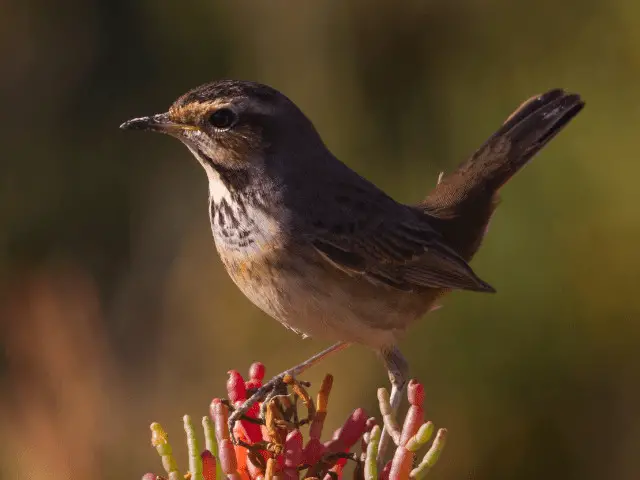Birds chirping is a dawn chorus that is a sign of morning for us. It gives a calming effect that provides us with motivation and relaxation to start the day. All bird species have their reason and schedule for chirping.
However…
Do you also find birds chirping at night weird? Well, they provide an enchanting or eerie experience as we all know that nighttime is the schedule for rest and sleep, right?
In this, we will provide you with information about some birds that give you ambient sounds by chirping. Of course, we will try to answer all your curiosities about them and provide you with a soothing experience as you do bird watching.
Take a moment to read to find out more about them. Enjoy!
7 Of The Most Fascinating Chirping Birds
1. Eastern Whip-Poor-Will
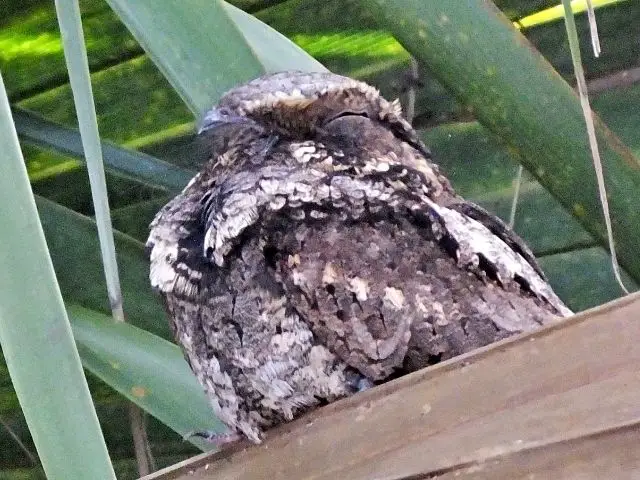
This bird, which has the scientific name of Antrostomus Vociferus, is a medium-sized member of the nightjar family. What makes this bird unique is its ability to camouflage with the body it has.
Other contributing factors may be its length which results up to 22 cm to 27 cm, its approximately 42 g to 69 g of weight, with a wingspan of 45 cm to 50 cm. It has a lifespan of 4 years.
These birds solely base their diets on insects such as grasshoppers, beetles, moths, stoneflies, wasps, fireflies, and many more.
Hearing Eastern Whip-Poor-Will chirp may be rare, but it is possible. This is due to them being nocturnal birds, making them only chirp at night.
2. Yellow-Breasted Chat
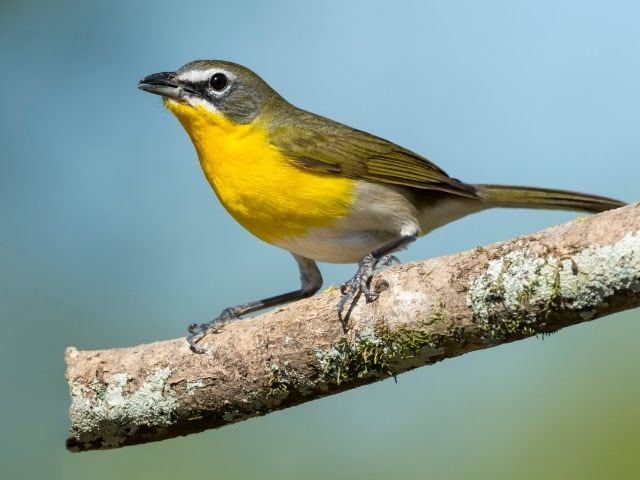
The Yellow-Breasted Chats are songbirds that can only be found in North America. They were once considered one of the new world warblers family but are now the only Icteridae family member.
They can grow up to 17 cm to 19.1 cm in length, about 20 g to 33 g in weight, with a wingspan of 23 cm to 27 cm. They can live for about 5 to 8 years.
You can identify these by referring to their name. They have bright yellow throat and breast, with dark white olive to white downward shade.
They mainly eat insects and berries, but blackberries and wild grapes are their preferred food.
The chirping they perform is a combination of whistles, hoots, and clucks. Although they’re diurnal birds chirping at night, a particular spring season is the only time they start singing in the evenings.
3. Barred Owl

The Barred Owl, which can grow up to 40 cm to 63 cm in length, 610 g to 1.5 kg, with 96 cm to 125 cm of wingspan, is a carnivorous bird that can live for about ten years.
They are also known as “Hoot Owls,” commonly found in the eastern part of North America. Their appearance has mantles that have white bars, with several white spots on their covert wings.
An owl is known to be a night bird which is why they actively chirp at night.
Fun Fact: Owls love to hoot especially in the evenings! Know why they do this by reading "Why Do Owls Hoot?" and be in for a surprise!
4. Common Loon

The Common Loons, also known as “Great Northern Diver,” are one of the largest members of the Loon family, growing up to 66 cm to 91 cm in length, with a weight of 2.2 kg to 7.6 kg, and a wingspan of 127 cm to 147 cm.
Both sexes of this species are very similar, but the males are usually heavier than the females. They can live for about 9 to 15 years.
Their broad black head with black wings, white underpants, and a wide, gray bill with a pointed edge.
Threat and loneliness are the reasons for their chirping and calling at night or tremolo.
5. Common Nightingale
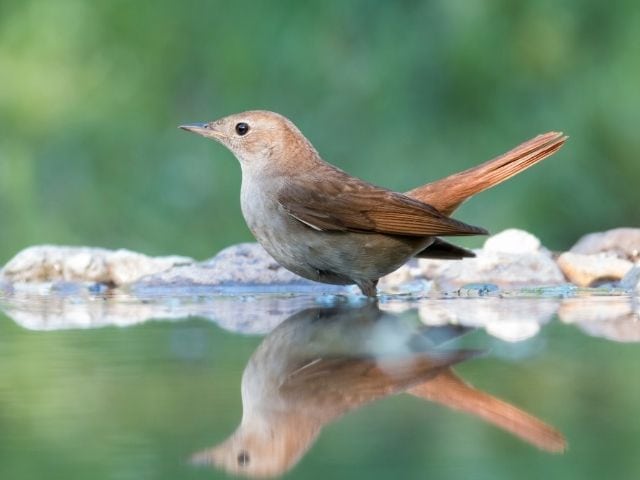
A Nightingale or Luscinia Megarhynchos is also known as the “Rufous Nightingale.” These are small birds that belong to the passerine family.
They can grow up to 15 cm to 16 cm in length, approximately 25 g in weight, with a wingspan of 25 cm—their lifespan s 1 to 8 years.
In the past, they belonged to the family of thrushes but now belong in the family of the old-world flycatchers. Their size can be compared to European Robins.
The only difference is that these birds are slightly larger and contain a faded, rufous body and reddish tail. You can identify them by their underpants that range from white to dull yellow in the shade.
6. Northern Mockingbird
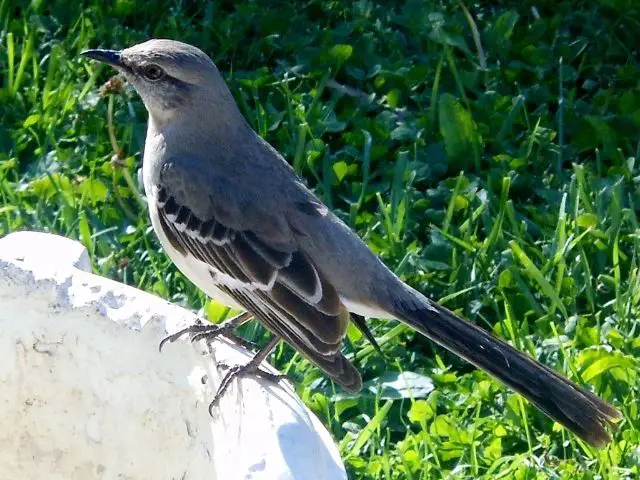
The Northern Mockingbird or Mimus Polyglottos are birds that can only be found in North America. They’re considered one of the passerine birds of the new world family (mimids) that have dark gray top and paler underpants.
They are measured 20.5 cm to 28 cm in length, 40 g to 58 g in weight, with 31 cm to 38 cm of wingspan. Their lifespan reaches up to 8 years in the wild and 20 years in captivity. They can learn up to 200 variations of songs which makes them a veritable avian playlist.
Moreover…
Sadly, the population of these birds has been decreasing and has waned over 20% in the last 50 years.
7. Barn Owl
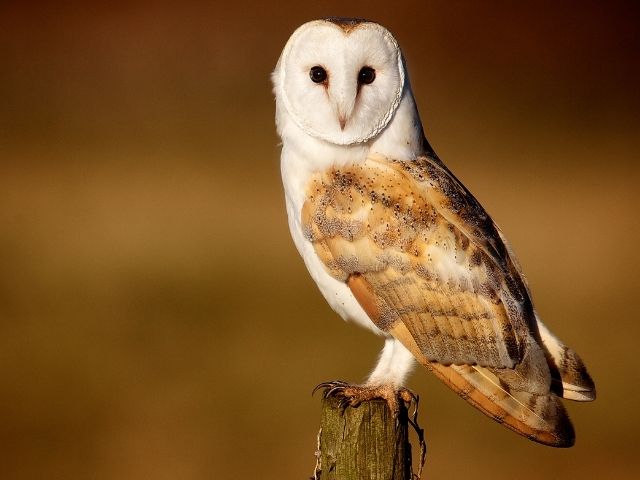
A Barn Owl or a Tyto Alba is an owl that doesn’t belong to the family of true owls. Despite this, its species is considered one of the most attractive and most widespread owls.
Its length can be up to 33 cm to 39 cm, weighing approximately 224 g to 710 g, with an 80 cm to 95 cm wingspan. On the other hand, its lifespan can last about four years.
Even more beautiful is its heart-shaped face, which looks rounder and cuter due to the lack of ear tufts. Their bodies’ shade can range from brown to gray, with upper parts darker than their underpants.
Of course, barn owls are just like any other owls. They are nocturnal birds; thus, they chirp often at night.
Fun Fact: Hooting is one thing but giving meaning to this is another. Know the mystery behind the owls -- superstitious beliefs, symbolism, and animal spirit -- to appreciate them more!
Frequently Asked Questions
Is it normal for birds to chirp at night?
No. Birds chirping at night are sometimes because of confusion -- this happens when their sleeping habits are affected by streetlights and other light pollution. Birds rise early and try to rest at dawn. A Dawn chorus is a sign of a brand new day.
Birds such as thrushes and robins are commonly confused about the time. This results in being active when it should be their resting time.
Chirping occurs as birds react to danger. A threat such as the shaking of their nest or a loud noise can wake them, causing a bird song as an alarm.
Also, they react and follow others when a bird starts to sing in a dawn chorus.
Why do birds chirp at night?
Birds have their reasons for chirping at night and multiple answers come up for this behavior. They try to claim territory and food by giving signals, look for mates by attracting their attention, alarm danger, reorient due to light pollution, find the flock, call the parents of the young birds to return, perfect their song, and know the number of birds in a population.
Watch about Nightingale and other night singers below:
What can I do about a bird that is chirping all night long?
Most mockingbird families chirp at night as they’re either young, unattached males, or lost their mates. The best way to silence their chirping is by attracting a female one to your backyard, too. Plus, a cover for your tree and a bed net can be a great solution. However, you need to constantly check on it as small birds may be stuck and entangled in it.
The Bottom Line
We consider bird songs relaxing and calming until it wakes you up in the middle of the night. It becomes a disturbance that isn’t pleasing at all.
People who live in suburbans tend to complain about this too often as these birds hinder their rest.
With this information, you now know which bird species cause trouble. It is a step towards your desired peaceful night!

